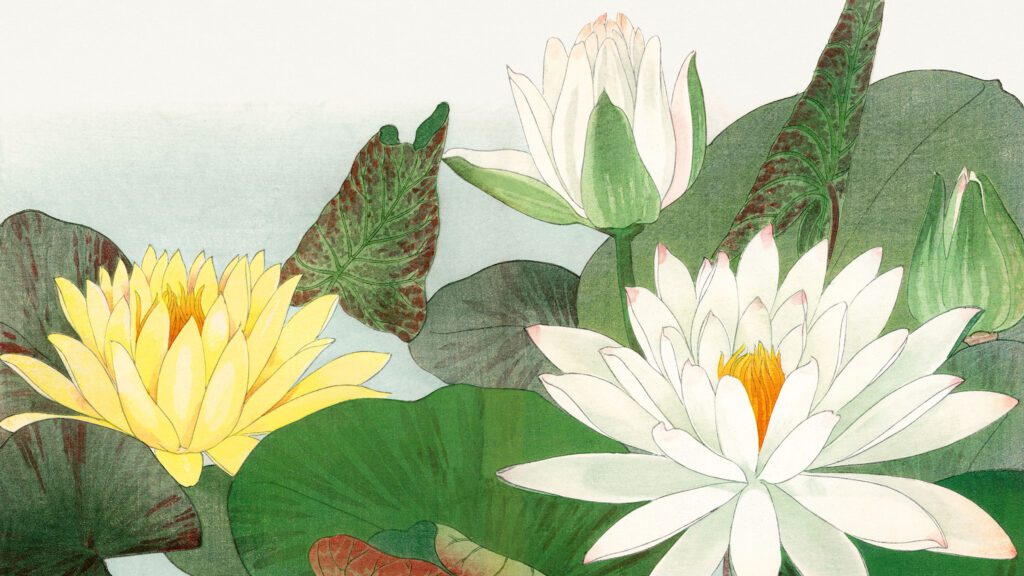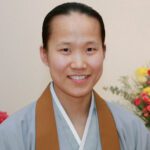The Seven Factors of Awakening
From mindfulness to joy to equanimity — when you cultivate beautiful qualities, they nourish your life and spiritual practice and enable you to be an agent of change in the world. Seven Buddhist teachers explain how. The post The...

Mindfulness
Mindfulness is the fulcrum of the seven factors of awakening, says Dawn Mauricio. It helps you balance the other factors.
For many of us, mindfulness serves as the doorway into our practice. However, because it has become so mainstream, or because it appears first in the list of the seven factors of awakening, it’s easy to overlook the profundity of mindfulness or disregard it as a beginner’s practice. We might be tempted to focus on what seem like the “better” or “more important” factors further in the list, but mindfulness is deserving of our full attention.
Sati is the Pali word most often used to translate “mindfulness,” and has a literal meaning of remembering or recollecting. In addition to remembering to be mindful, the invitation with sati is to remember the Buddha’s teachings and instructions we’ve received. Without this remembering, we risk getting lost in reactive patterns or making unwise choices in practice and in life.
Personally, I love mindfulness. It’s incredible to think that through cultivating this one quality, we can experience greater ease, freedom, and steadiness of heart and mind in the midst of our daily lives. I also love how adaptable mindfulness is; its essence shifts and takes on different flavors depending on the context or the particular Buddhist teaching it’s connected to.
 Hasu by Megata Morikaga / Rawpixel
Hasu by Megata Morikaga / RawpixelIn regards to the seven factors of awakening, mindfulness acts as a fulcrum, working in harmony with the other six factors to foster liberation. It’s an inherently skillful quality. One of its most powerful functions is its ability to bring balance to the mind no matter what we’re experiencing—a low or high level of energy, or pleasant or unpleasant emotion.
For example, with mindfulness we might become aware that we’re feeling sluggish, so then we’ll know to practice the energizing factors of awakening—investigation, energy, and joy. On the other hand, mindfulness might help us see that we’re restless or anxious, in which case we’ll know to lean into the calming awakening factors—relaxation, concentration, and equanimity. In this way, mindfulness provides the insight to assess where we are mentally and emotionally and what we need to restore balance.
When mindfulness is strong, it will begin to feel natural and unavoidable, as though it’s the very essence of your being. You already have this inherent capacity to be mindful, but it’s easy to think, in a world rife with distraction, that you don’t. To remind yourself of your innate ability to be mindful, try this short and simple exercise: Set a timer for fifteen seconds. During that time, try to not be mindful at all—don’t be mindful of thoughts or sounds or sensations or anything.
Did you “succeed” at not being mindful? Most likely not, which is a good thing! This exercise shows us that mindfulness is indeed part of our natural essence. For those of you who think you were able to not be mindful, I have news for you—you were mindful that you weren’t being mindful! When intentionally cultivated, mindfulness as an awakening factor deepens this inherent ability, making it both unshakeable and self-sustaining.
An additional aspect of mindfulness is that mindfulness pairs with discernment. The compound quality mindfulness-discernment encourages us to remember to abandon unskillful factors and develop skillful ones. In other words, when faced with challenges, mindful discernment helps us reflect on what tools, instructions, or responses were or were not skillful in similar situations in the past. In this way, mindfulness provides us with insight into how we can respond wisely to what’s arising now.
Meditation deepens our capacity for mindfulness, but the true potential of mindfulness is realized when it becomes a continuous thread woven into all aspects of life. Whether we’re engaging in conversation, facing challenges, or simply resting in a moment of self-care, mindfulness sees whatever is arising, remembers the instructions, and empowers us to meet each moment with clear, loving awareness.
 Temple hanging (noren) (19th century), lotus flower fabric textile, Original public domain image from The Minneapolis Institute of Art.
Temple hanging (noren) (19th century), lotus flower fabric textile, Original public domain image from The Minneapolis Institute of Art.Investigation
Dawa Tarchin Phillips on how to investigate the true nature of reality—and find freedom.
Have you ever paused in the middle of a conversation only to realize that you and the other person are experiencing completely different realities? Same place, same time, but different reality. This happens because reality has three ingredients: that which can be and is perceived, the act of perceiving itself, and the ones who perceive it.
Everything we experience, learn, and come to know about the world and ourselves through any mode of study, observation, or inquiry, whether scientific or spiritual, is subject to these fundamentals. It either belongs to the realm of the perceiver, the act of perceiving, or the realm of that which is perceived. In the dharma, we refer to these as “the three circles.” We attribute a different quality to each of these three aspects of our everyday experience. We do so through descriptions, labels, and judgments—finding both pleasure and pain in our daily perceptions and experiences.
Pain arises when we have an uncertain or unhealthy relationship with these three circles. Unsettled by attachment, aversion, or ignorance, we find ourselves wondering if a certain perception and experience is going to enrich our sense of self or detract from it, and whether we are dealing with enemies or friends. We oscillate between the hope of gain and the fear of loss—all while we actively fail to clearly discern who it is that is perceiving what, what the act of perceiving actually consists of, and why that matters. We experience confusion, bewilderment, tension, conflict, and emotional friction between the perceiver, the act of perception, and that which is perceived. Sometimes, this process itself becomes unbearable. However, there is another way.
Dharma training has a simple but not a simplistic objective: to stabilize and train the mind to perceive reality both as it is and as it appears—object, perception, and perceiver included.
This insight is valuable and critical for two reasons. First, investigating and understanding how perceived objects appear can give us a head start in not misreading or misinterpreting them but clearly identifying them for what they are, thus discovering their fleeting, illusory nature as they arise from seemingly nowhere, abide beyond our grasp, and dissolve without a trace.
Second, investigating and understanding how the perceiving mind perceives can free us from dualistic fixation and the belief that we ourselves are permanently existing, independent selves. We see that we’re not trapped in our experience; we’re not trapped in an endless battle with our own perceptions. We are, in fact, not separate from what we perceive—not separate from the world around us and each other.
Practice allows us to sharpen our attention and awareness, so that we remain free from distraction and focused on the way things are and not just the way they appear. Then we discover that the nature of reality means that there can be stillness in the noise, calm in the storm, and space in all physical forms. Nothing else can offer this experience and realization, nothing else can offer us such profound reconciliation of the joy and pain of being alive.
It is both endlessly profound and profoundly simple. See the truth, and the truth will set you free. The nature of reality—your nature, my nature—is beyond grasping and fixation, inherently clear, blissful, and unbound by labels, concepts, and constructs. When we investigate what we perceive, how we perceive it, and who is doing the perceiving, the struggle dissolves. The tension collapses. What remains is direct experience, free, open, and uncontrived. In that space we realize: who we are, where we are, and what is happening has always been total freedom. Nothing more, nothing less.
 Kannon Kyo I by Mayumi Oda
Kannon Kyo I by Mayumi OdaEffort
Myokei Caine-Barrett, Shonin, on why faith is such a powerful source of energy.
The third factor of enlightenment, viriya, is not necessarily such a clear concept to describe. This Sanskrit term translates as “energy,” “effort,” “determination,” or “diligence.” It is connected to the eightfold path’s samma vayama, or “right effort,” and to the fourth paramita, viriya parami, which is also rendered as “the perfection of effort” or “the perfection of perseverance.”
Energy and effort are related concepts, as any effort requires an expenditure of energy. What reasons do we have to exert effort, and how do we have the energy to do so?
I am drawn to the notion of purpose and/or mission as the impetus. I believe that the impetus to follow the Buddhist path initially arises in the moment when we experience the joy of encountering the dharma and feel compelled to take refuge and further explore the path. In Nichiren Buddhism, this is called ichinen zuiki, a single moment of rejoicing. As one continues to develop, one gains ichinen shinge, a single moment of faith based on understanding. Continuity of practice solidifies this foundation of joy and wisdom within one’s heart and mind.
I remember well the many moments of joy I’ve experienced in my own practice, which were followed by moments of understanding and faith. As a woman of mixed ethnicity, I would often wonder why I was born this way in a time when being of mixed ethnicity was not acceptable. My practice became my anchor. It grounded me in the idea from the Lotus Sutra that I was a child of the Buddha and therefore worthy. I began to recognize that my own parents, imperfect in their ways, were also bodhisattvas guiding me to the experience of my true self. I learned that the obstacles and problems I faced were essentially the means for meeting and understanding my true self. This faith sustains me still.
What I have learned is that the understanding and faith that grow within as we practice are the sources of the energy or effort we make to develop a life that reveals the presence of dharma while being directed by the dharma.
Consider the women who traveled great distances to visit Nichiren Shonin, the founder of Nichiren Buddhism, during the thirteenth century in Japan. These arduous journeys were often made by horseback or walking over long distances. I imagine the women did not necessarily travel alone and perhaps would have a small escort; regardless, they would face many dangerous obstacles. Yet because of their faith, they did not hesitate to travel to meet with their teacher and provide gifts to support his life.
The stories of Japanese war brides, including my own mother, are another clear reflection of the power of faith as the driving force for all the efforts made to survive the loss of family and home and the overwhelming racism they experienced. Faith was the only reliable support to endure intolerable circumstances while trying to adapt to a whole new world.
Holding family gatherings, meetings, and chanting sessions, the women persevered to create the sacred community in safe spaces where they could support each other and teach their children. Some suffered the impacts of both alcoholism and domestic violence, yet they persevered, because they could do nothing else. Remarkably, the power of their efforts sometimes changed their husbands into ardent supporters, also taking faith in the dharma.
In the end, it is understanding our vow and commitment that allows each of us to have the energy to persevere through all circumstances. As understanding grows, there is less hesitancy in applying ourselves to deeper levels of practice to ensure that we reach enlightenment, no matter what.
 Ducks by Goyō Hashiguchi, courtesy of the Los Angeles County Museum of Art
Ducks by Goyō Hashiguchi, courtesy of the Los Angeles County Museum of Art Joy
What does joy have to do with concentration? Norman Fischer explains.
The word “joy” in English seems to imply a kind of abandon—“I was overcome with joy.” We think of joy as something that comes upon us suddenly, spontaneously, often for no reason. It’s both physical—felt in the body as an effortless lightness—and spiritual, as if we were uplifted by a divine force that somehow pervades the senses, so that the whole world around us seems easeful. I’m not sure any of this is in the dictionary, but it’s what I hear in the word “joy.”
All this is not far from the technical Buddhist word piti, the enlightenment factor often translated as “joy.” Joy is a sensation that arises in a meditator when they begin to concentrate—to go beyond the ordinary boredom of sitting still in meditation, struggling with a ragged mind. It takes some effort, but the mind finally clicks in and can stay with the meditation object without much struggle. And joy arises.
In The Path of Purification, the renowned fifth-century Buddhist philosopher Buddhaghosa delineates five kinds of piti: minor, momentary, showering, uplifting, and pervading. His description of them is entertaining. Minor piti raises the hairs on the body; momentary piti is like flashes of lightning that come and go brilliantly; and showering piti breaks over the body like waves. Uplifting piti, Buddhaghosa says, literally lifts the body, so that it levitates or flies.
The fifth kind of joy, pervading joy, is the highest and most important sort. It completely suffuses the body, filling it like a bladder, or like a rock cavern inundated by a great wave. With pervasive joy, the first stage of concentration, the first jhana, is achieved. The mind is so firm in its concentration, that the five hindrances—desire, ill will, sloth and torpor, agitation and worry, and doubt—cannot possibly arise, and are replaced by the five wholesome factors associated with concentration. These five factors are: applied thought and discursive thought (the ability to easily take up and stay with the meditation object, usually the breath), plus joy, bliss, and unification of mind. Bliss is an intensification and completion of piti.
In my own practice experience, and in my witnessing of the experience of others, meditative concentration does follow this pattern, if perhaps more loosely. Ordinary life is full of agitation, desire, and aversion, even when you have a more or less happy life and things go well. There are always exasperations and problems; the world does not appear pristine and magical. But when you practice meditation thoroughly enough to experience concentration, the world inside and out transforms—you do feel joy, not only within, but all around you.
On the Buddhist path, concentration practice is necessary but not sufficient. It’s no small thing to realize through your own direct experience that the world is not a fixed entity—the world as it appears to you is dependent on your state of mind. What one moment seems like a big problem can in the next seem perfectly all right when your mind is joyful and calm.
But knowing this is not enough, especially if it makes you dependent on peaceful meditation practice, which you can’t always do. The next step is learning to manage your mind at all times, whether meditative joy is present or not. To learn this, you need to foster insight and to stabilize the mind so that it can have enough equanimity to see what’s going on. Then you’ll see suffering as suffering and know how to live with it peacefully. Eventually, you’ll cultivate a good-humored evenness and stability, regardless of circumstances or mental states. To be awakened is to be able to keep your balance all the time—not to depend on or become addicted to joy.
It’s noteworthy that in the Buddhist system of four concentration states, the factors of joy and bliss are present only in the first two. The second two of the four basic concentration states go beyond joy to a powerful equanimity and peacefulness.
 Photomechanical print by Ogawa Kazumasa, courtesy of The Rijksmuseum.
Photomechanical print by Ogawa Kazumasa, courtesy of The Rijksmuseum.Relaxation
Larry Ward and Peggy Rowe Ward on how to let go of trying, grasping, striving—and refresh your body and mind.
In the late nineties, we went on a retreat with Thich Nhat Hanh in the sports auditorium at the University of California, Santa Barbara. On our first morning of meditation, he offered the chant along with three sounds of the bell. Two minutes into the silence, he softly said “relax,” and we heard one thousand bodies, hearts, and minds shifting posture.
We’d not noticed how tight our bodies were until we received this invitation to relax. Initially, we noticed that we were “trying” to meditate. We were excited to be with our teacher and wanted to “do it right.” We were “working” at meditation. Clearly, we weren’t relaxed—and we weren’t the only ones.
Thay, as Thich Nhat Hanh is affectionately known, said that when he first came to the U.S., he felt that Westerners were too tired, busy, and uptight to sit. He suggested that total relaxation may be a better daily practice for us.
To practice total relaxation, lie down on your back and invite your body to settle. Notice where the body makes contact with the ground. Shoulders, bum, thighs, calves, feet in contact with the earth. Now bring awareness and relaxation to each part of your body. Maybe you can start with your scalp and then move onto your forehead, eyes, nose, cheeks, mouth, shoulders, etc. After you’ve scanned and relaxed your whole body, bring your attention to your abdomen rising and falling with each inhalation and exhalation. Don’t worry if you fall asleep. Just relax. A full session of total relaxation might last twenty minutes to an hour.
Relaxation is more than a stress-free moment. It’s a whole body-mind experience. There’s a quality of awareness that’s soft and strong at the same time. We witness this with great athletes, musicians, artists, and cooks. We see this with children and puppies at play. We sometimes know relaxation as grace.
Relaxation is essential for accessing the tranquility and joy that lead to increased personal well-being. Thay said that if we relax, we’ll “become calm water, and we will reflect reality as it is. If we’re not calm, the image we reflect is distorted. When the image is distorted by our minds, it’s not the reality, and it causes suffering.”
Calming the body and mind doesn’t happen through force of will. Relaxing is an art of body and mind. They inter-are in the calming process. Our fight, flight, or frozen responses slowly disarm.
Peggy begins her practice by asking before she meditates, “Am I safe?” She says this silently or out loud, as she looks inside and outside of the body. Then she answers, “I am safe,” if this is the case. It’s difficult to relax when the nervous system is anxious and activated. We nourish ourselves in the present by remembering the safety and beauty that rests within us.
If we practice in a way that does not tire us out, this gives the body and consciousness a chance to rest and restore themselves. Embrace the body with the warm light of mindfulness, noticing as slower, calmer energy begins to grow. This is a chance to look deeper within oneself, making mental notes. Naming what’s contributing to this experience of wellness is important. The mind can begin to relax when it’s finding more moments and glimmers of stillness.
The art of relaxing the mind begins with nonclinging to our thinking. We let thinking be itself. We do not fight it. And soon it begins to settle. We’re invited to pay attention to our mental habits. We recognize them with kindness and curiosity, and we call them by name. We accept ourselves just as we are, looking deeply to inquire about the liberation that rests within. This is how the mind relaxes. It lets go of trying, grasping, striving. Together the body and mind help each other relax.
Relaxation becomes an embodied experience and not just a wish. In practicing relaxation every day, it becomes a habit—our default setting, overriding the habit of reactivity. As this happens, pleasure and happiness increase. The ease that is calmness arises, and it counteracts restlessness and worry about the past or the future. And here we are, standing like a great tree amid it all.
 Painting of flowers in a vase by G. A. Audsley
Painting of flowers in a vase by G. A. AudsleyConcentration
Doyeon Park offers four tips for cultivating a calm and focused mind.
In today’s fast-paced and distraction-filled world, the ability to concentrate is a practical yet rare skill that can help you navigate the complexities of daily life. In Buddhism, however, concentration is far more than that—it’s a transformative quality necessary for the journey toward enlightenment (bodhi) and liberation (nirvana).
The term “concentration” is the most common translation of the Pali word samadhi, which conveys a state of collectedness, calm, and focus. Concentration refers to a state of deep mental absorption cultivated through intentional and sustained practice. It allows the mind to rest fully on a single object—such as the breath, a mantra, or any chosen focus—letting distractions dissolve and enabling the mind to become steady and unified.
Many people turn to meditation seeking a peaceful mind, free from worries and disturbances. While this serenity enhances well-being, in Buddhism, it’s not the ultimate goal. Samadhi, a calm and focused mind, creates the conditions for wisdom to arise, serving as a gateway to enlightenment. With a calm, clear mind, we can observe phenomena as they arise and pass away, gaining insight into their impermanent and interdependent nature—a realization that’s key to ending suffering.
Concentration doesn’t come naturally for most of us; it requires deliberate practice and intention. This can be done in both formal meditation and in daily life. Whether eating, working, or washing dishes, concentration can manifest in any activity when we’re fully present, calm, and focused, without distractions pulling us away.
Here is some practical guidance for cultivating concentration.
Protect Your Inner Peace
Sotaesan, the founder of Won Buddhism, said, “In all your actions, do nothing that will disturb or devastate your spirit, and avoid such sensory conditions.”
In other words, protecting inner peace starts by avoiding unnecessary disturbances. Just as maintaining a clean room begins by avoiding messes, a calm mind requires steering clear of actions or habits that trigger anxiety or agitation.
Do you consume media that fosters envy or worry, or engage in arguments that leave you unsettled? Letting go of such behaviors declutters both your inner and outer environment, creating space for serenity and focus.
Cultivate a Dispassionate Attitude
According to Sotaesan, we should not entertain craving or greed in responding to any matter. Instead, we should habituate ourselves to having a dispassionate attitude.
Approaching situations objectively—free from attachment or aversion—develops a steady mind. A dispassionate attitude helps you respond to stress or conflict with clarity, reducing emotional reactivity. By lessening the push and pull of craving, you strengthen both concentration and composure, enabling wiser decision-making.
Focus Fully on the Task at Hand
In a multitasking culture, we often believe juggling multiple tasks is efficient. However, research shows it divides attention, slows us down, and increases errors. So, as Sotaesan put it, “When you are doing one thing, don’t be distracted by something else.”
Give your full attention to one task at a time. Whether eating, cleaning, or having a conversation, immerse yourself completely in that moment. This will not only boost productivity, it will also foster peace and satisfaction as you engage fully with the present.
Deepen Concentration Through Meditation
Meditation is the most direct path to developing samadhi. Start small, dedicating a few minutes daily to sitting quietly. Over time, this practice becomes second nature, extending its benefits to all areas of life.
Mindful activities like reciting the Buddha’s name or bringing focused awareness to everyday actions further help maintain a calm and centered mind. Cultivating concentration is not limited to meditation—it’s a way of living.
By avoiding disturbances, letting go of attachment, and practicing mindfulness, we create the conditions for a calm, clear mind to flourish. Such practices enhance our individual well-being and prepare us for the deeper wisdom that leads to liberation. Concentration, as a gateway to inner peace, helps us live with clarity, resilience, and a profound connection to the dharma.
 Nymphaea lotus from Seiyô SÔKA ZUFU by Tanigami Kônan
Nymphaea lotus from Seiyô SÔKA ZUFU by Tanigami KônanEquanimity
Koshin Paley Ellison on the practice of staying steady, even in the face of hateful speech.
“Aren’t you scared to keep your mezuzah up? I took mine down,” said my friendly neighbor on our floor in an apartment building in Manhattan. A mezuzah is a Jewish symbol of protection on the right side of the doorways in most Jewish homes.
“What if they come for you?”
she asked.
“I will be here,” I responded.
This is a challenging time for many people. So, I’ve been returning again and again to the refuge of the buddhadharma, especially the refuge of equanimity. This teaching is about meeting whatever comes our way with the dignity of staying upright. It’s easy to say, but how do we actually do this?
I often think about the story attributed to the great Rinzai teacher Hakuin. In the town where he lived, there was an unmarried woman who got pregnant. She was in love with the baby’s father, but her parents didn’t approve of him, so she lied and claimed that Hakuin was the father. The parents went to the temple and said that Hakuin was disgusting. It was horrible that he did this to their daughter! His response was “Oh, is that so?” No defense.
When the baby was born, they brought the child to Hakuin and said, “This is your child.” And he said, “Oh, is that so?” He raised the child as his own. But eventually, the woman confessed that it was not, in fact, Hakuin’s child. Embarrassed, the parents went to Hakuin and said, “We’re so sorry. The child isn’t yours. We’re going to take the child back.” He just said, “Oh, is that so?”
That’s equanimity, the unwavering quality of just being with whatever life presents. The eight worldly winds that we’re all subject to are loss and gain, good repute and ill repute, praise and censure, sorrow and happiness. Equanimity helps us be like a strong tree when these winds blow. We’re intimate with all that comes to us without bypassing anything.
I’ve gotten hateful emails and even face-to-face comments made to me over the last year because I’m Jewish. Some make assumptions about my politics and attack me as a “a genocidal Nazi fuck,” “Jew pig,” “a fake Buddhist Jew lover.” Just as I don’t believe every Muslim should need to publicly denounce the behavior of the Taliban, I refuse to make public pronouncements to prove I’m a “good Jew.”
Most of the comments I’ve gotten have nothing to do with Israel and are simply anti-Jewish. We live in a time when discrimination is increasing all over the world, and I know it’s far from limited to Jews. It’s something all minorities are experiencing.
If we’re blown over by hateful speech, even if it’s racist speech, how will we keep on being a refuge for others? How will we be a refuge for ourselves? It’s with equanimity that we can meet stereotyping and injustice with dignity.
But we need to recognize equanimity’s “near” and “far” enemies. The far enemy of equanimity is desire, attraction, or greed. We want to be respected, seen, known, loved. These are natural, blameless desires, yet there are times when we’ll be disrespected, misunderstood, unknown, and held in contempt. This is just a fact. Not accepting this fact makes it worse, more of a struggle.
This is not to say that we should try to spiritually bypass the experience of discrimination by pretending to ourselves that it doesn’t hurt, or that we shouldn’t do something about it. What I’m saying is that we need to be able to hold to our truth in the face of discrimination and not let it take us down or entangle our mind in ignorance, greed, and hatred.
The near enemy of equanimity, that which can seem like equanimity but isn’t, is indifference. Hakuin’s type of response, especially today, is often misunderstood. It’s seen as you don’t care.
I’ve been told that I’m indifferent when I refuse to feel sorrow for only one group or when people think I only have sorrow for one thing and not for something else. Meanwhile, I take refuge in the bodhisattva vow to serve all beings equally. This is to allow my heart to ache for the suffering and pain of all people and beings and the earth and to rejoice in the beauty and joy that also exist.
Can we make room for different perspectives? Can we remain calm when someone hates us and not return hatred for hatred?
Like I told my concerned neighbor, “I will be here.” Let’s encourage each other to walk the bodhisattva way with equanimity for the sake of all beings. Let’s do it together.

Dawn Mauricio is a meditation teacher who teaches with organizations such as Spirit Rock Meditation Center, the Omega Institute, and Sounds True.

Dawa Tarchin Phillips is Founder/CEO of Empowerment Holdings and co-founder of the Mindful Leadership Online Training Conference. He is a mindfulness and meditation expert, author, entrepreneur, spiritual teacher, researcher and educator. He is the acting President of the International Mindfulness Teachers Association, and founder of the Mindful Leadership Tribe.

Myokei Caine-Barrett, Shonin, was the first American woman and the first person of African Japanese descent to receive full ordination as a Nichiren priest. Today, she is the bishop of the Nichiren Shu Buddhist Order of North America. Based in Houston, where she is the guiding teacher of Myoken-ji Temple, she also leads two prison sanghas and has been active in Healing Warrior Hearts (a program for veterans returning home) and The Gathering: Buddhist Teachers of Black African Descent.

Larry Ward is a senior teacher in Thich Nhat Hanh’s Plum Village tradition. He holds a PhD in religious studies (with an emphasis on Buddhism and the neuroscience of meditation), is director of the Lotus Institute, and serves as an advisor to the Executive Mind Leadership Institute at the Drucker School of Management. He is the author of America’s Racial Karma and coauthor, with his wife, Peggy, of Love’s Garden: A Guide to Mindful Relationships.

Dr. Peggy Rowe Ward is an ordained dharma teacher who, with Larry Ward, directs the Lotus Institute and co-authored Love’s Garden: A Guide to Mindful Relationships.

Zoketsu Norman Fischer is a poet, essayist, and Soto Zen Buddhist priest who has published more than thirty volumes of poetry and prose, including most recently When You Greet Me I Bow. He is the founder of Everyday Zen, a community based in the San Francisco Bay area, as well as former abbot of the San Francisco Zen Center. He and his wife, Kathie Fischer, also a Soto Zen priest, have two children and three grandchildren and live in Muir Beach, California.

Rev. Doyeon Park is a Kyomunim, literally meaning one who devotes oneself to teach Buddha dharma in the Won Buddhist tradition. She has served as a minister of the Manhattan Won Buddhist temple and a representative of Won Buddhism at the United Nations since 2008. She is the Buddhist Religious Life Adviser at Columbia University and the Buddhist chaplain at New York University.

Koshin Paley Ellison is an author, Zen teacher, Jungian psychotherapist, leader in contemplative care, and co-founder of an educational non-profit called the New York Zen Center for Contemplative Care. His latest book is Untangled: Walking the Eightfold Path to Clarity, Courage, and Compassion.

 JaneWalter
JaneWalter 



















![The 2026 AI Search Benchmark Every SEO Leader Needs [Webinar] via @sejournal, @lorenbaker](https://www.searchenginejournal.com/wp-content/uploads/2025/11/1-259.png)










